Sierra Leone: The West African nation welcoming the world
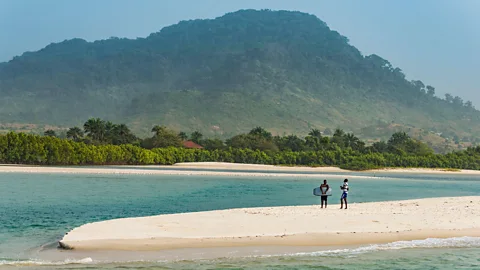 Alamy
AlamyA new generation of Sierra Leoneans is eager to show visitors that the nation's civil war is long gone and reintroduce one of Africa's great destinations to the world.
Sitting in the shade of a palm tree on Tokeh Beach, one of Sierra Leone's many postcard-worthy, white-sand waterfronts, Peter Momoh Bassie told me his story. "I am not ashamed to say I was part of the rebels because I was captured by force," he said, looking out over the emerald-coloured water. "I never killed anyone," he added.
Stories like Bassie's abound in Sierra Leone, a small nation in West Africa with more than 300km of coastline sandwiched between Guinea and Liberia. The country's 11-year civil war that ended in 2002 killed more than 50,000 people and displaced 2.6 million more. The rebels captured Bassie when he was just 11 years old. He was held captive for six years, managing to escape – and get caught again – three times.
Today, Bassie works as a tour guide for Tourism Is Life, one of many Sierra Leonean travel companies eager to show the world that the nation is now safe and introduce visitors to its many rainforests, beaches and rich cultural experiences.
Though the war ended more than two decades ago, its legacy – compounded by a 2014 Ebola virus outbreak – has meant that Sierra Leone remains something of an off-the-beaten-path destination, attracting only a small fraction of the visitors who venture to nearby Ghana or Senegal, for example.
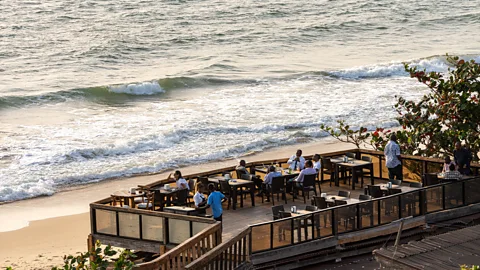 Yulia Denisyuk
Yulia DenisyukIn its pre-war tourism heyday of the 1980s, visitors were drawn to Sierra Leone's beachfront locations like Bureh, another white-sand haven an hour's drive south from its energetic capital, Freetown. But beyond its famous western coastline, this Scotland-sized nation boasts a stunningly diverse array of landscapes. In the south-east, the Gola rainforest and Tiwai Island Wildlife Sanctuary are home to chimpanzees, rare Diana monkeys, Bongo antelopes and more than 320 bird species. In the north, the Outamba-Kilimi National Park is a woodland savannah and sanctuary for hippos, elephants and colobus monkeys. And in the east, plateaus lead up to Mount Bintumani, one of West Africa's highest peaks.
Dubbed "the forgotten industry" by some residents, tourism is now becoming a focus for Sierra Leone once again. A multi-year World Bank development project is underway, training tourism staff, building infrastructure and developing ecotourism sites in areas like south-eastern Sierra Leone, where the elusive – and endangered – pygmy hippo lives.
Now, a new generation of Sierra Leoneans wants visitors to reconsider what their country is all about.
A new beginning
"Growing up, I would hop around Tokeh Beach and Maroun Island, drink coconuts, get a lobster, and cook it for lunch," said Wissam Stanger Sfeile, a freediving coach who competed for Sierra Leone in the freediving world championships. In 2016, he co-founded Bafa, an eco-resort on the northern tip of Banana Islands, a lush trio of islands south of Freetown.
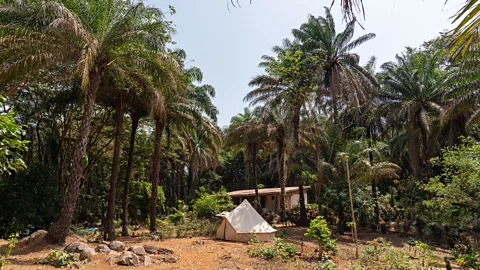 Yulia Denisyuk
Yulia DenisyukAt Bafa, hammocks swayed in the breeze and glamping tents were spread throughout the shore as fresh lobster sizzled on the grill. Together with his wife Emily, Sfeile wanted to recreate the experience he had as a child. The eco-resort leases the land from the nearby fishing community of Dublin. Sfeile buys fish and produce from Dublin and employs youth from the community. "I wanted others to experience our nature in a space where guests could enjoy the beauty of trees, flowers and beaches," he explained.
Beyond their natural appeal, the country's islands were the setting of one of history's most tragic events: at the peak of the transatlantic slave trade in the 17th and 18th Centuries, they became one of the main departure points to the New World for enslaved West Africans.
According to the Slave Voyages digital initiative, roughly 400,000 people were sent through the British trade ports in Sierra Leone from 1501 to 1866. Of them, Bunce Island, was the most prolific. It's situated halfway between Senegal and Liberia, the area then known as the Rice Coast. From here, British slave traders sold people with a particular knowledge – how to grow rice – to plantation owners in South Carolina and Georgia. An estimated 30,000 people walked through the "door of no return" on this quiet island with a now-crumbling fort, exiled by colonial enslavers to the rice-growing colonies in the West Indies and North America.
The Banana Islands once served as the substation for Bunce, and that history is still visible today. The community of Dublin traces its roots to descendants of emancipated Africans who started returning to Sierra Leone after the abolition of slave trade by Britain in 1807. Rusted cannons and a mass grave near the Bafa resort hold the memory of those who tried to resist their fate.
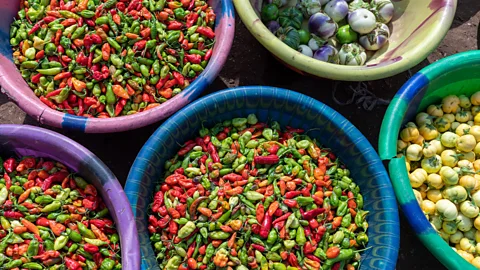 Yulia Denisyuk
Yulia DenisyukA creative capital
Freetown, the country's capital and largest city, is rooted in resistance, too. The crowded port city at the foot of the verdant Peninsula Mountains was founded in the late-18th Century by formerly enslaved people from England, North America, the Caribbean and beyond. Their descendants became known as the Krios, an ethnic group whose language, Krio, is still the lingua franca in Sierra Leone today.
On a cosy rooftop with string lights south of Freetown, London-raised chef Susan Senesie serves meals she grew up with, such as extra spicy goat pepper soup or tamarind pie. Her Treat Food restaurant in Funkia, a neighbourhood with a large fish market, creates fine-dining versions of local dishes.
"When I used to visit [family in] Sierra Leone over holidays, I had difficulty dining out, because there was no authentic local restaurant here," she told me. "It was disheartening." Though at first people questioned her decision to put cassava leaves on a canape when cassava is traditionally served with a mountain of rice, the concept took off. Today, Senesie offers cooking classes, and her restaurant trains and hires people who were disabled during the war.
Artist Hawa Bangura is another repatriate who returned hoping to help the nation recover. Her paintings tell stories of African women while tackling themes of identity, heritage and cultural reclamation. "The slower pace of life in Sierra Leone gave me time to explore the ideas and narratives of African history, which was never taught in the schools I attended in the West," she explained.
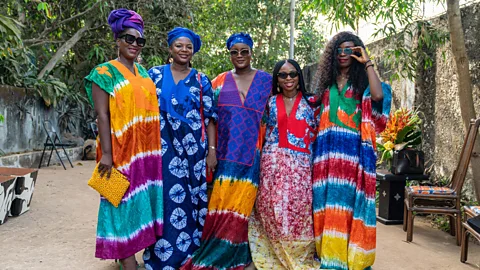
Bangura practiced law in New York before returning home in 2007. In Freetown, she founded The Barray, a collective of artists promoting Sierra Leone's contemporary visual art scene. "The civil war devastated the creative sector," said Bangura. "But we are resilient people. Our creative community, including art, music, fashion, film and theatre, is beginning to heat up."
That excitement was evident at MaryAnn Kaikai's regular salon in western Freetown, where a dozen women gathered one evening under the shade of mango trees. Kaikai is the creative force behind Madam Wokie, a Sierra Leonean fashion label showcased in New York, Johannesburg and other international cities. Kaikai echoed Bangura's feelings, saying that with everything Sierra Leoneans have been through – losing limbs in the war or suffering through Ebola – they are not bitter. "We have this fighting spirit where we say Tel God Tenki, ["I tell God thank you" in Krio], and we move on," she explained.
Kaikai designs vibrant clothes and accessories for her community and beyond; actors Eva Mendes and Idris Elba, an honourary Sierra Leonean, are among the brand's customers. Partnering with the World Bank and the Ministry of Tourism, Kaikai recently trained local women to become future tourism entrepreneurs and artisans, equipping them with skills like gara tie-dyeing, a traditional plant-based craft. The designer is optimistic about the future: "Despite everything, there's always that feeling of hope."
The legacy of resistance
Heading north-west out of Freetown, I watched busy markets and the rush of tuk-tuks disappear from view. A dense forested landscape took over. Wild mango and cashew trees rose over red soil. Villages gave way to colossal palms and micro-farms. This is the Northern Province, the nation's sparsely populated farmland and cattle-rearing region.
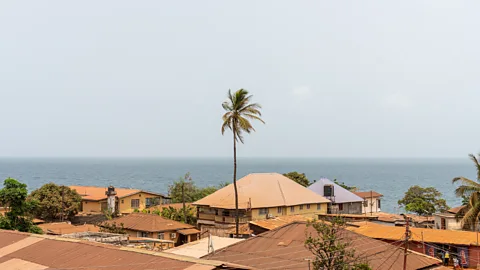 Yulia Denisyuk
Yulia DenisyukThe striking Wara Wara mountains overshadowed the landscape in the town of Kabala, situated in the remote Koinadugu district. As we hiked to the top of a nearby hill, passing local kids selling cashew nuts by the road, Bassie told me that historical resistance to slavery flourished here, thanks to the many caves and rocky outcrops where people could hide.
Few written records exist, but one points to the natural rock fortress of Old Yagala just outside of town where hundreds of people are said to have joined forces to resist enslavement. After the slave trade was over, the British Empire turned Sierra Leone into a Crown Colony. Shortly after, a local man named Bai Bureh led another rebellion against British forces.
More like this:
• Teraanga: The word that defines Senegal
Retelling stories like these is at the heart of what Bimbola Carrol does. Twenty years ago he founded VSL Travel after seeing mostly negative coverage of his country. "I felt that if we were looking to get back on our feet, we needed to show people another side of Sierra Leone," he told me.
Today, Carrol organises a range of trips: to the small village of Rogbonko in the Northern Province where travellers can stay in thatched-roof huts with the local community, or to the Western Peninsula near Freetown to spot the white-necked rockfowl, one of Africa's rarest and most peculiar birds. "Everyone who comes to Sierra Leone falls in love with our nation," said Carrol. "We are lagging behind other countries, but the world is starting to take note. For me, that is cause to be optimistic about the future."
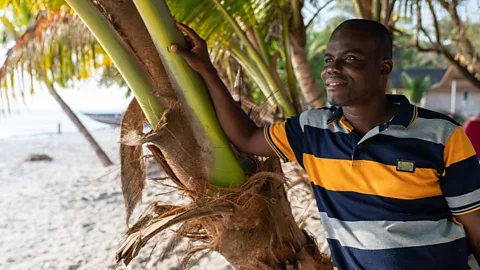 Yulia Denisyuk
Yulia DenisyukIndeed, there are signs of change. In 2023, a new solar-powered airport opened near Freetown. A new visa-on-arrival programme starting in 2019 has made it easier for travellers to plan trips. And the nation's newly established flag carrier, Air Sierra Leone, announced plans to start direct flights from Gatwick to Freetown in the near future.
Back in Freetown, Bassie dreams of opening his own tourism school one day. "Tourism brings everyone closer," he told me. The hope here is to bring more travellers closer to Sierra Leone in the years to come.
--
If you liked this story, sign up for The Essential List newsletter – a handpicked selection of features, videos and can't-miss news, delivered to your inbox twice a week.
